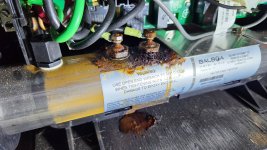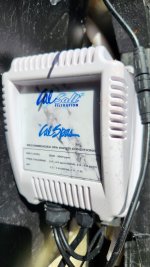Long time lurker, first time poster. First would just like to say thanks for the support this forum has provided.
I have a 13 month old Cal Spa with factory SWG (aka Saltron Mini). Tonight I discovered my heater cartridge has corroded itself badly enough to trip the GFI.
I follow this forums guidelines pretty religiously. But to summarize my water care techniques:
Temp 101-102
SWG runs 1 to 2 hrs per day depending on usage, Free Chlorine hovers between 1 and 5 (it can swing up a lot if we don't use the spa for a few days, but more commonly is between 2 and 4). It has been as high as 10 when the SWG ran away from me for a week or so, or when raising to SLAM which I have only done once.
CC is generally 0.1 - it dropped WAY down after cleaning with Ahhsome and this also reduced my overnight chloring consumption significantly.
I add borates via Boric Acid until 50ppm
When starting up, I use dichlor until CYA is at 30, then switch to the SWG or pure chloring as-needed.
Salt 2500ppm
Since buffering with borates by pH is much more stable but does drift up. I add dry acid ever few weeks to bring it down to approx 7.6, but it's generally between 7.4 - 7.8. Before borates, it would climb up to 8.2 pretty quick.
Because of the dry acid use my TA does drop. I add baking soda to bring it back up to ~80ppm every few months.
My water comes out of the tap with almost zero calcium for whatever reason. I add Calcium Carbonate until CH is 170.
I fill with a filter (provided with my SWG kit)
The spa filter runs ~20 hrs per day via circ pump, and two ozonators run for those ~20 hours as well.
I test with a Taylor K2006.
I HAVE seen some damage to plastics and headrests including discoloration of the spa cover. I'm not sure if this is from the ozone or chlorine, or is normal.
Is anything I'm doing going to cause this kind of corrosion? It's a Titanium heater - I would have expected this system to have lasted longer.

Edit: Photo size for visibility.
I have a 13 month old Cal Spa with factory SWG (aka Saltron Mini). Tonight I discovered my heater cartridge has corroded itself badly enough to trip the GFI.
I follow this forums guidelines pretty religiously. But to summarize my water care techniques:
Temp 101-102
SWG runs 1 to 2 hrs per day depending on usage, Free Chlorine hovers between 1 and 5 (it can swing up a lot if we don't use the spa for a few days, but more commonly is between 2 and 4). It has been as high as 10 when the SWG ran away from me for a week or so, or when raising to SLAM which I have only done once.
CC is generally 0.1 - it dropped WAY down after cleaning with Ahhsome and this also reduced my overnight chloring consumption significantly.
I add borates via Boric Acid until 50ppm
When starting up, I use dichlor until CYA is at 30, then switch to the SWG or pure chloring as-needed.
Salt 2500ppm
Since buffering with borates by pH is much more stable but does drift up. I add dry acid ever few weeks to bring it down to approx 7.6, but it's generally between 7.4 - 7.8. Before borates, it would climb up to 8.2 pretty quick.
Because of the dry acid use my TA does drop. I add baking soda to bring it back up to ~80ppm every few months.
My water comes out of the tap with almost zero calcium for whatever reason. I add Calcium Carbonate until CH is 170.
I fill with a filter (provided with my SWG kit)
The spa filter runs ~20 hrs per day via circ pump, and two ozonators run for those ~20 hours as well.
I test with a Taylor K2006.
I HAVE seen some damage to plastics and headrests including discoloration of the spa cover. I'm not sure if this is from the ozone or chlorine, or is normal.
Is anything I'm doing going to cause this kind of corrosion? It's a Titanium heater - I would have expected this system to have lasted longer.

Edit: Photo size for visibility.
Last edited:





